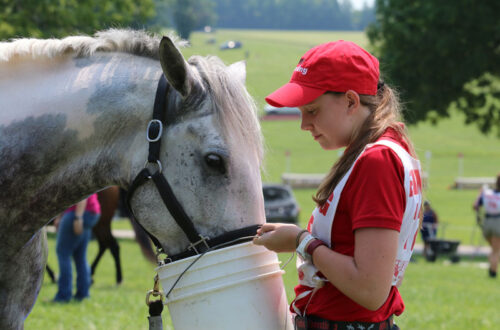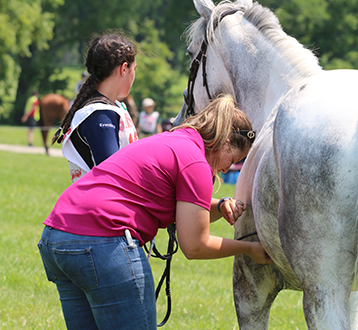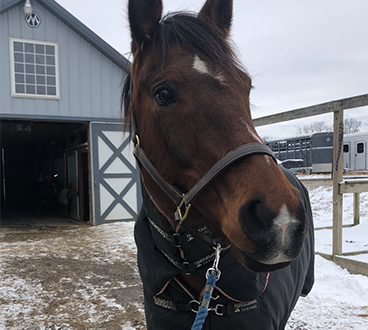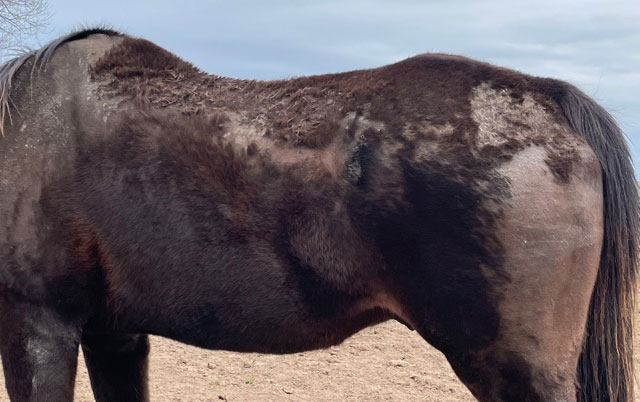
Good Grooming Goals: Dealing with Rain Rot
By Liv Gude
Brought to you by Shapley’s, the Official Grooming Product Sponsor of Pony Club
Our horse’s skin is an amazing organ! It’s part of the integumentary system, which also includes hooves and whiskers. Skin is also the largest organ that horses have. The skin’s job is to help your horse regulate his body temperature through the hair coat and sweating. Your horse also needs his whiskers and skin to receive touch and help him navigate his surroundings. Lastly, your horse’s skin is part of the immune system, helping to prevent bacterial and fungal skin infections.
Parts of the Horse’s Skin
Parts of your horse’s skin have particular functions. Sweat glands in the skin provide cooling when your horse needs to drop his body temperature—perhaps due to a winter coat on a warm day, or if he’s sweating due to exercise.
Sebaceous glands in the skin produce sebum, a natural oil with anti-microbial functions. Sebum also provides waterproofing in the winter and makes a haircoat shiny in the summer.
The hair follicles in the skin are the source of every hair on your horse’s body. The winter coat releases from the hair follicles in the spring, and a new summer coat grows in. The follicles release the summer coat in the fall, replacing it with a long winter coat. Every hair follicle contains one hair and links directly to a sebaceous gland. This allows every hair on your horse to have some valuable sebum.
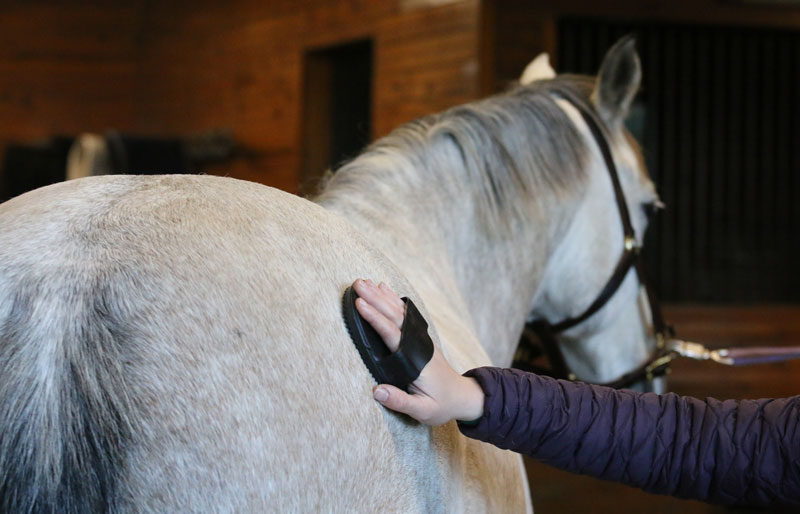
A Common Equine Skin Infection
Sometimes horses develop skin problems. Horses get rubs from tack and blankets, wounds from playing in the paddocks, or skin infections from bacteria and fungus.
Rain rot is a common skin infection in horses caused by bacteria. It is not caused by rain specifically but rather a damp environment. Rain, sweat, humidity, dirty saddle pads, dirty grooming tools, and improper blanketing and grooming can create rain rot.
The hair will fall out as the bacteria grow in a rain rot infection. The skin also develops a crusty and scaly texture. Usually it’s not itchy but may become so. Some cases of rain rot damage the skin and allow secondary infections of more bacteria or fungus to invade. Rain rot usually happens on the dorsal side of your horse—the top side from ears to withers to croup to tail.
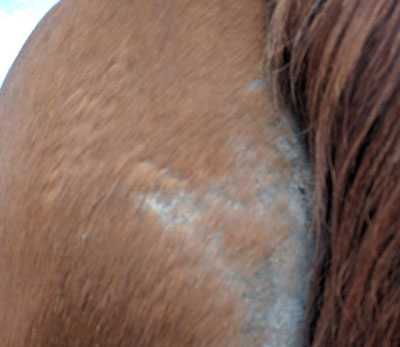
Rain rot will spread to other horses, usually with grooming tools. Each horse in the barn should have separate tack, saddle pads, blankets, and grooming products to help eliminate the spread of bacteria. If any tack or saddle pads are shared, it’s best to clean them before using them on another horse.
Other types of skin infections may look like rain rot. Sweet itch, which is an allergic reaction to tiny gnats, and ringworm, which is a fungal infection, resemble rain rot. Lower leg skin infections are often the result of bacteria in mud and dirty shavings.
Any time you notice a problem with your horse’s skin, talk to your vet. Many skin issues have different treatments and require unique solutions.
Help Treat Rain Rot
Using detergents and harsh shampoos may only worsen rain rot. Damaged skin is sensitive and might be further irritated by strong ingredients. Healthy skin needs plenty of sebum, and harsh shampoos will remove that. Your horse’s skin will do much better when you can retain as much sebum as possible.
Specialty shampoos, such as Shapley’s MediCare shampoo, contain ingredients like tea tree oil that help eliminate bacteria and fungus, while keeping the skin soothed and happy. MediCare shampoo also contains lemongrass oil, an anti-microbial ingredient. Lemongrass oil helps repel irritating insects, which are worse when skin is infected.
Preventing Rain Rot
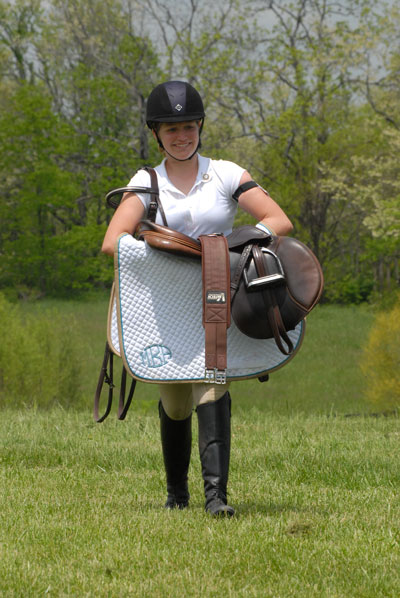
Take care of your horse’s skin and haircoat daily to prevent rain rot. Thoroughly groom your horse using clean brushes. Notice any missing hair or extra dandruff as you inspect your horse’s skin and coat.
Don’t share grooming tools, blankets, saddle pads, or girths. If you need to share saddle pads and girths, only share them after washing the saddles pads and cleaning your tack.
In the summer, ramp up the insect control plan on your farm. Some flies and bugs like to carry bacteria from horse to horse. Fly sheets are a great way to minimize any risk.
When blanketing horses for bad or cold weather, remove the blanket daily for grooming. If there is any sweat, change your blanketing routine and groom thoroughly. The goal with blankets is to keep your horse comfortable without sweating.
Don’t put blankets or sheets on a sweaty or wet horse. Use fleece coolers or wool coolers to soak up any sweat or water, and then blanket your horse. A dry horse is less likely to develop rain rot.
Keep your horse’s skincare at the top of your grooming routine, and you will be able to catch and treat any skin problems early. Your vet can confirm any diagnosis and help you develop a successful treatment plan.
Help the Hair Grow BackAs a rain rot infection is healing, your horse may need help with itching and hair growth. The ingredients in Shapley’s M-T-G have been a time-honored solution to alleviate rain rot signs and help the hair grow back.M-T-G is powerful, and a little bit goes a long way. Do a patch test of this oil-based treatment to test the ingredients before you use it to treat rain rot. To patch test, apply a few drops to the inside of your horse’s upper leg and wait 24 hours. The skin should stay happy and healthy. Then you can apply to any affected areas on your horse. It’s best to apply M-T-G in the evenings using your fingertips to massage a few drops into the rain rot patches. M-T-G can also be used on the mane’s base and tail’s dock to promote hair growth. |
This article about rain rot in horses was originally published in the Spring 2022 issue of Discover USPC magazine. Read more content from that issue.
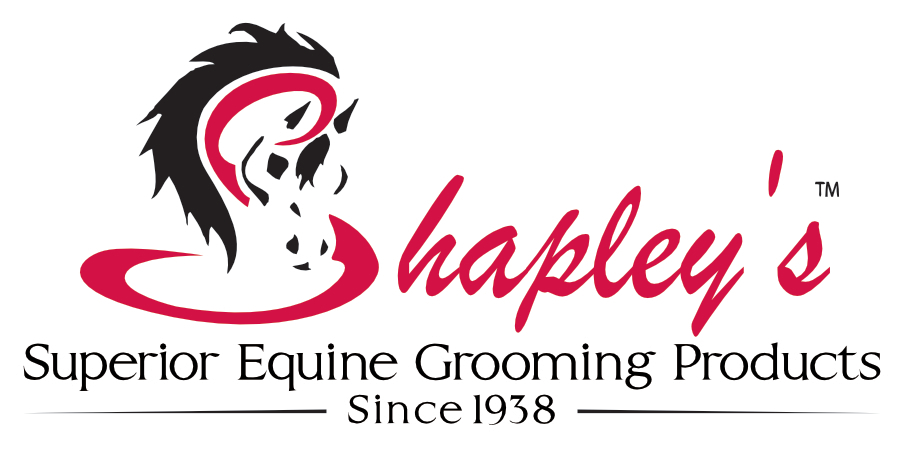
About Shapley’s — Official USPC Grooming Product Sponsor
Shapley’s has been producing superior equine grooming products for over 85 years, and top riders and horsemen trust Shapley’s for their horse’s health and shine. Learn more at Shapleys.com



